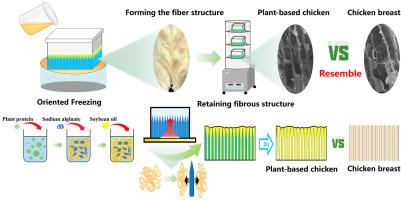An oriented freezing strategy for fabricating fibrous structures of plant-based chicken analog
IF 11
1区 农林科学
Q1 CHEMISTRY, APPLIED
引用次数: 0
Abstract
The increasing global demand for sustainable protein has driven significant research interest in plant-based meat analogs, which are expected to exhibit a fibrous structure resembling animal muscle tissue. In this study, we proposed a simple approach to fabricate plant-based chicken analogs using oriented freezing with a custom-designed apparatus. Pea, fava bean, and mung bean protein were applied at 10 wt% and 15 wt%, and the obtained analogs were systematically compared with chicken breast in structural, physicochemical properties, and oxidative stability. Macroscopic and microscopic analyses confirmed well-aligned fibrous networks in the analogs, comparable to the hierarchical structure of chicken breast. The analogs prepared by oriented freezing showed higher water-holding capacity and better thermal stability, with thermogravimetric profiles closely matching chicken breast. Furthermore, analogs formulated with a high protein weight percentage (15 wt%) exhibited low carbonyl level, indicating that oriented freezing could be an effective method to mitigate protein oxidation in plant-based meats. Among all formulations, the 15 wt% fava bean protein-based analog exhibited the best structural properties comparable to chicken breast, as revealed by appearance and protein secondary structure distribution. It is speculated that the unidirectional ice growth driven by the temperature gradient accounts for the phase separation and protein alignment into muscle-like fibers. This study demonstrates that oriented freezing is a promising novel strategy for generating fibrous structures in plant-based meats, offering potential advantages in terms of easy operation and gentle processing.

植物基鸡模拟物纤维结构的定向冷冻制备策略
全球对可持续蛋白质的需求不断增长,推动了对植物性肉类类似物的重大研究兴趣,预计植物性肉类类似物将表现出类似动物肌肉组织的纤维结构。在这项研究中,我们提出了一种简单的方法,利用定制的设备定向冷冻制备植物性鸡类似物。豌豆、蚕豆和绿豆蛋白分别以10 wt%和15 wt%的重量添加,得到的类似物与鸡胸肉在结构、理化性质和氧化稳定性方面进行了系统比较。宏观和微观分析证实了类似物中排列良好的纤维网络,可与鸡胸肉的分层结构相媲美。定向冷冻制备的类似物具有较高的保水能力和较好的热稳定性,其热重曲线与鸡胸肉的热重曲线非常接近。此外,高蛋白质重量百分比(15 wt%)的类似物表现出低羰基水平,表明定向冷冻可能是减轻植物性肉类中蛋白质氧化的有效方法。在所有配方中,15%蚕豆蛋白基类似物的外观和蛋白质二级结构分布显示出与鸡胸肉相似的最佳结构特性。据推测,温度梯度驱动的单向冰生长解释了相分离和蛋白质排列成肌肉样纤维的原因。这项研究表明,定向冷冻是一种很有前途的新策略,可以在植物性肉类中产生纤维结构,在操作简单和加工温和方面具有潜在的优势。
本文章由计算机程序翻译,如有差异,请以英文原文为准。
求助全文
约1分钟内获得全文
求助全文
来源期刊

Food Hydrocolloids
工程技术-食品科技
CiteScore
19.90
自引率
14.00%
发文量
871
审稿时长
37 days
期刊介绍:
Food Hydrocolloids publishes original and innovative research focused on the characterization, functional properties, and applications of hydrocolloid materials used in food products. These hydrocolloids, defined as polysaccharides and proteins of commercial importance, are added to control aspects such as texture, stability, rheology, and sensory properties. The research's primary emphasis should be on the hydrocolloids themselves, with thorough descriptions of their source, nature, and physicochemical characteristics. Manuscripts are expected to clearly outline specific aims and objectives, include a fundamental discussion of research findings at the molecular level, and address the significance of the results. Studies on hydrocolloids in complex formulations should concentrate on their overall properties and mechanisms of action, while simple formulation development studies may not be considered for publication.
The main areas of interest are:
-Chemical and physicochemical characterisation
Thermal properties including glass transitions and conformational changes-
Rheological properties including viscosity, viscoelastic properties and gelation behaviour-
The influence on organoleptic properties-
Interfacial properties including stabilisation of dispersions, emulsions and foams-
Film forming properties with application to edible films and active packaging-
Encapsulation and controlled release of active compounds-
The influence on health including their role as dietary fibre-
Manipulation of hydrocolloid structure and functionality through chemical, biochemical and physical processes-
New hydrocolloids and hydrocolloid sources of commercial potential.
The Journal also publishes Review articles that provide an overview of the latest developments in topics of specific interest to researchers in this field of activity.
 求助内容:
求助内容: 应助结果提醒方式:
应助结果提醒方式:


